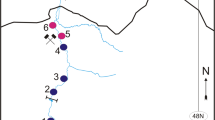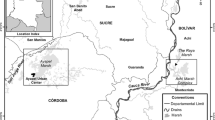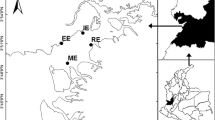Abstract.
Mercury pollution was compared in two Oregon reservoirs of similar size and age, located within the same ecoregion. Cottage Grove Reservoir was distinguished by a history of mercury mining and processing within its watershed, while Dorena Reservoir was not. Mercury concentrations in sediments of the reservoirs, tributary streams, and three species of fish were measured. Sediment mercury concentrations in the main tributary of Cottage Grove Reservoir, which drains the subbasin where past mercury mining occurred, was tenfold higher than mercury in sediments from other reservoir tributaries. There were no significant differences between sediment mercury concentrations in the tributaries of Dorena Reservoir. The average mercury concentration in the basin sediment of Cottage Grove Reservoir (0.67 ± 0.05 μg/g dry wt) was higher than for Dorena Reservoir (0.12 ± 0.01 μg/g dry wt). At Cottage Grove Reservoir, maximum mercury concentrations were near or exceeded 1 μg/g wet wt for largemouth bass (Micropterus salmonides) and bluegill (Lepomis macrochirus) epaxial muscle. Muscle mercury concentrations in largemouth bass and crappie (Pomoxis nigromaculatus) from Cottage Grove Reservoir were significantly higher than from the same species from Dorena Reservoir. Numbers of bluegill of the same age available from both reservoirs were too small for statistical comparisons. Mercury concentrations in largemouth bass muscle fluctuated annually in both reservoirs. Fish ages were consistently positively correlated with muscle mercury concentrations in only the point-source-impacted reservoir. These results indicated that a point source, Black Butte Mine, contributed amounts of mercury greatly in excess of mobilization from natural deposits, atmospheric deposition, and small-scale uses of the metal as an amalgamating agent in gold mining.
Similar content being viewed by others
Author information
Authors and Affiliations
Additional information
Received: 12 September 1996/Accepted: 22 July 1997
Rights and permissions
About this article
Cite this article
Park, JG., Curtis, L. Mercury Distribution in Sediments and Bioaccumulation by Fish in Two Oregon Reservoirs: Point-Source and Nonpoint-Source Impacted Systems. Arch. Environ. Contam. Toxicol. 33, 423–429 (1997). https://doi.org/10.1007/s002449900272
Issue Date:
DOI: https://doi.org/10.1007/s002449900272




